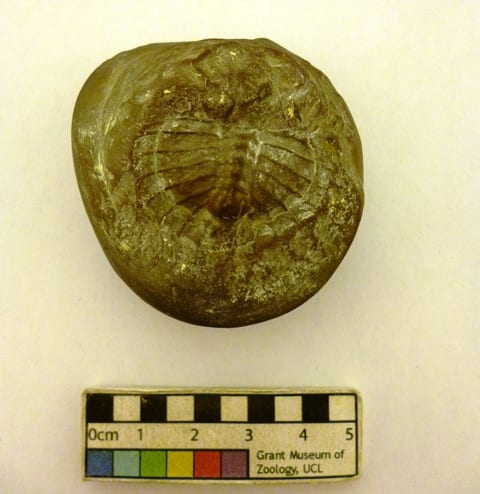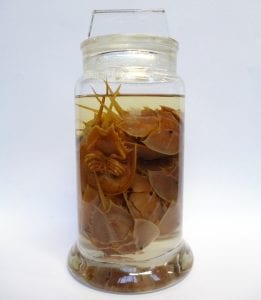Specimen of the Week 272: Jar of Horseshoe Crabs
By zcqsrti, on 30 December 2016
Doors open and in rushes a gust of cold air, shortly followed by a hurried flurry of wrapped up rosy faces. Here at the Grant Museum of Zoology, winter is a time of pressed noses on cabinet glass, and hungry eyes peering in at vivid sugary denizens of the cupboard. Come one, come all and experience Grant’s famous jelly moles, cotton candy wasp nests, liquorice joeys and of course the week’s special, all the way from America, the hard candy horseshoe crabs…
~~Jar of Horseshoe Crabs~~
Bags of Crabs?
Obviously these horseshoe crabs, just like the rest of the specimens in the museum are not technically edible, but if we were indeed a sweet shop, these guys would be selling like hotcakes…
There are a grand total of four horseshoe crab species, ranging in distribution throughout Asia to the East Coast of America. While the only American species is the Atlantic horseshoe crab (Limulus polyphemus), the remaining Asian species include the mangrove horseshoe crab (Carcinoscorpius rotundicauda) and two sharing the same genus Tachypleus (respectively T. gigas and T. tridentatus). Just like almost all the promisingly fun things in nature, horseshoe ‘crabs’ are not actually ‘crabs’, yet their name strongly implies otherwise. What they lack in crustaceousness, they make up as being part of the sub-phylum ‘Chelicerata’, along with Arachnids and Pycnogonids (sea spiders); in truth they share a startlingly close common ancestor with spiders. Even more startlingly so, this evolutionary position was ascertained in this very museum, and using our very own specimens, by the Grant Museum’s former director and famous evolutionary biologist E. Ray Lankester.
They’d probably win Robot Wars
The horseshoe crab represents nature’s closest analogue to ‘Chaos 2’ who, way back in the year 2000, was reigning champion of both season 3 and season 4 of ‘Robot Wars’. Like the CO2-powered pneumatic flipper boasted by Chaos 2, horseshoe crabs also posses an elongate tail that when deployed enables the arthropod to right itself (albeit in a more fumblesome manner than the dramatic half somersault Chaos 2 is capable of). Here’s a video for the robotically inclined…
https://www.youtube.com/watch?v=4NUn993f0W4
However even a proficient flip-master might occasionally need a helping hand, which is why the American Ecological Research and Development Group who aid the conservation of endangered species and habitats across coastlines throughout America and Asia have developed the ‘Just flip ’em’ program, where beach-goers are encouraged to flip any stranded horseshoe crabs they find to reduce mortality rates during their breeding seasons.
More importantly, they are also bold survivors of the natural world, having settled on an extremely effective body-plan that has been evolutionarily stable for almost half a billion years. The earliest discovered fossil of a horseshoe crab dates from 445 million years ago, meaning species of horseshoe crabs have been around since the Late Ordovician (D.M. Rudkin et al. 2008) and the group has survived all five recorded mass extinction events on earth to date. To put that into perspective, horseshoe crabs have been pottering around way before plants had even begun to think about touching soil; and if that isn’t a characteristic that would impress the judges of Robot Wars, then I don’t know what is.

Fossil horseshoe crab from 310 million years ago, Euproops rotundata, with a strikingly similar body plan to modern species. LDUCZ-J23
Blood of the Ancients
Despite having survived a range of mass extinctions caused by snowball earths, destructive algal blooms, atmosphere saturated with poisonous gases and bolide impacts from outer space, our species of horseshoe crabs are sadly beginning to succumb to the ongoing pressures of human interference, and might themselves become extinct by the end of the anthropocene. Species like L. polyphemus are currently listed as vulnerable on the IUCN Red List of Threatened Species, and are expected to decline further in abundance as more and more coastal habitats are exploited and polluted. One of the main reason for the decline is their use in medical science. Horseshoe crab blood, instead of using haemoglobin for oxygen transport, uses the copper based haemocyanin instead, giving it a strikingly blue hue. In addition to this, the blood is also responsible for the horseshoe crab’s incredibly powerful immune system. Horseshoe crab amoebocytes, responsible for the coagulation (or clotting) of their blood, are able to coagulate far faster than mammalian blood in the presence of a ridiculously small amount of bacteria; a characteristic discovered by Jack Levin and Frederik Bang in the 1960s (Levin, J. and F.B. Bang 1968). In 1970 the Food and Drug Administration of America made it mandatory to carry out tests (called a ‘LAL’ test, short for Limulus amoebocyte lysate) using horseshoe crab blood on surgical implants and vaccinations, to ensure that they are safe for human use. Blood is harvested and bled individuals are released, but face a mortality rate of around 10%, which is made all the more pressing by the sheer demand of horseshoe crab blood. While we have the horseshoe crab to thank for our highly effective methods of vaccination, and saving the lives of an immeasurable amount of people as a result, it is time for us to develop further on our alternative methods to the LAL test, such as the Monocyte Activation Test (or ‘MAT’).
In Japanese folklore, horseshoe crabs are brave warriors, honorably sacrificed and reborn; now until evermore walking the sea floor. Numerous haiku, from many a ponderous mind have cast light on the mysterious horseshoe crab…
Have continued to survive in the Kasoka waters
Spring and Autumn a friend
A learned person gently comes, steps carefully
References
Rudkin, D.M., G.A. Young and G.S. Nowlan (2008). The Oldest Horseshoe Crab: a new xiphosurid from late ordovician konservat-lagerstätten deposits, Manitoba, Canada. Palaeontology 51: 1 – 9
Levin, J. and F.B. Bang (1968). Clottable protein in Limulus: Its localization and kinetics of its coagulation by endotoxin. Thromb Diathes Haemorrh (Stuttg) 19: 186
 Close
Close


